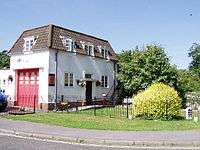Herbert Collins
| Herbert Collins | |
|---|---|
| Born |
1885 Edmonton, London |
| Died | 1975 |
| Nationality | British |
| Occupation | Architect |
| Practice | Collins & Calton |
| Buildings | 286 (building) |
| Projects |
Swaythling Housing Society Welwyn Garden City |


Herbert Collins (1885–1975) was a British architect, born in Edmonton, London.[1] He designed many of the suburban developments in the city of Southampton in the 1920s and 1930s.
Life
Collins designed houses in Southampton from 1922,[2] became a director of the Welwyn Garden City Company in 1924[3][4] and co-founded the Swaythling Housing society on 26 November 1925.[2] Collins, along with his cofounders, accountant and civic leader Fred Woolley (the society's first chairman) and Bursledon brickworks director Claude Ashby, put up £200 worth of shares.[2] Collins' father, William, loaned the fledgling company £14,000.[2]
Collins lived at 38 Brookvale Road in Highfield, Southampton from 1930 to 1973, and a commemorative English Heritage blue plaque was installed there in July 2004.[5] During his time living there, Collins was responsible for the design of Swaythling Methodist Church in Burgess Road, built in 1932.[6]
In an effort to contribute to the post-war housing efforts, Collins submitted a suggestion to the July 1945 edition of the journal Architectural Design and Construction regarding constructing bungalows from rammed earth combined with a small quantity of cement; his suggestion was repeated in The Architects' Journal in 1946.[7]
In 1957, Collins retired as a fellow of the Royal Institute of British Architects and his professional partnership with J. Normal Calton was dissolved by mutual consent; the pair had been trading as Collins & Calton.[8] At this time, Collins was living at 32 Carlton Crescent in Southampton.[8] Collins' retirement, however, did not mean an end to his interest in architecture and town planning, and in January 1962 a letter from Collins, sent from his Carlton Crescent address, was published in the Journal of the Town Planning Institute.[9]
Work
Collins' housing estates have a distinctive style, usually with rows of terraced houses set around wide areas of greenery. Two of the more notable Collins estates in Southampton (the Oakmount estate in Highfield and the Englemount estate in Bassett Green) have been designated as conservation areas by the city council,[10] and the Orchards Way estate in West End was designated a conservation area by Eastleigh Borough Council in 1999.[11] Collins was responsible for the ca. 1928 design of Glebe Court.
Collins also made plans for a garden city around Marchwood, but these proposals were unrealised.[2][3]
References
- ↑ "SeaCity Museum". Facebook. 19 October 2012. Retrieved 24 November 2012.
- 1 2 3 4 5 "Herbert Collins". The Southern Daily Echo. 21 June 2007. Archived from the original on 18 October 2010. Retrieved 18 October 2010.
- 1 2 Mann, John Edgar and Ashton, Peter: "Highfield: A Village Remembered". Halsgrove, 1998. ISBN 1-874448-91-4
- ↑ Purdom, C. B. (1925). The Building of Satellite Towns. J. M. Dent & Sons Ltd. pp. Appendix B.
- ↑ "English Heritage Blue Plaques in Southampton, Liverpool & Merseyside, Southampton, Birmingham and Portsmouth" (PDF). English Heritage.
- ↑ Mann, John Edgar (2002). Book of the Stonehams. Tiverton: Halsgrove. p. 118. ISBN 1-84114-213-1.
- ↑ "Rammed earth construction". The Architects' Journal. 103: 79. 1946.
- 1 2 "Collins & Calton dissolved". Royal Institute of British Architects Journal. 64: 164 & 245. 1957. Retrieved 8 October 2010.
- ↑ "Letter from Collins". Journal of the Town Planning Institute. 47–48: 79. 1961.
- ↑ Herbert Collins Residents' Association: Southampton Conservation Areas
- ↑ Eastleigh Borough Council: Orchards Way Conservation Area